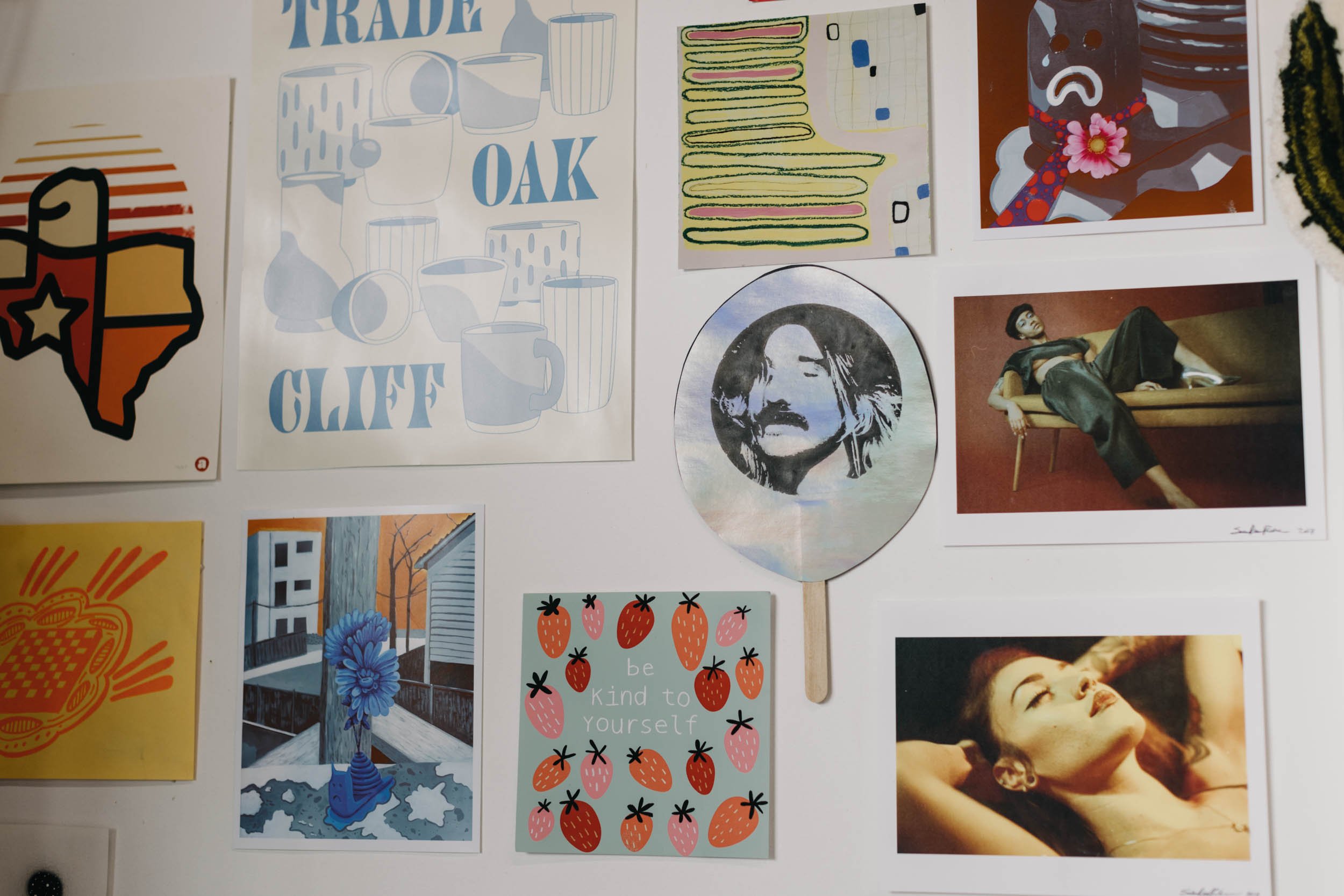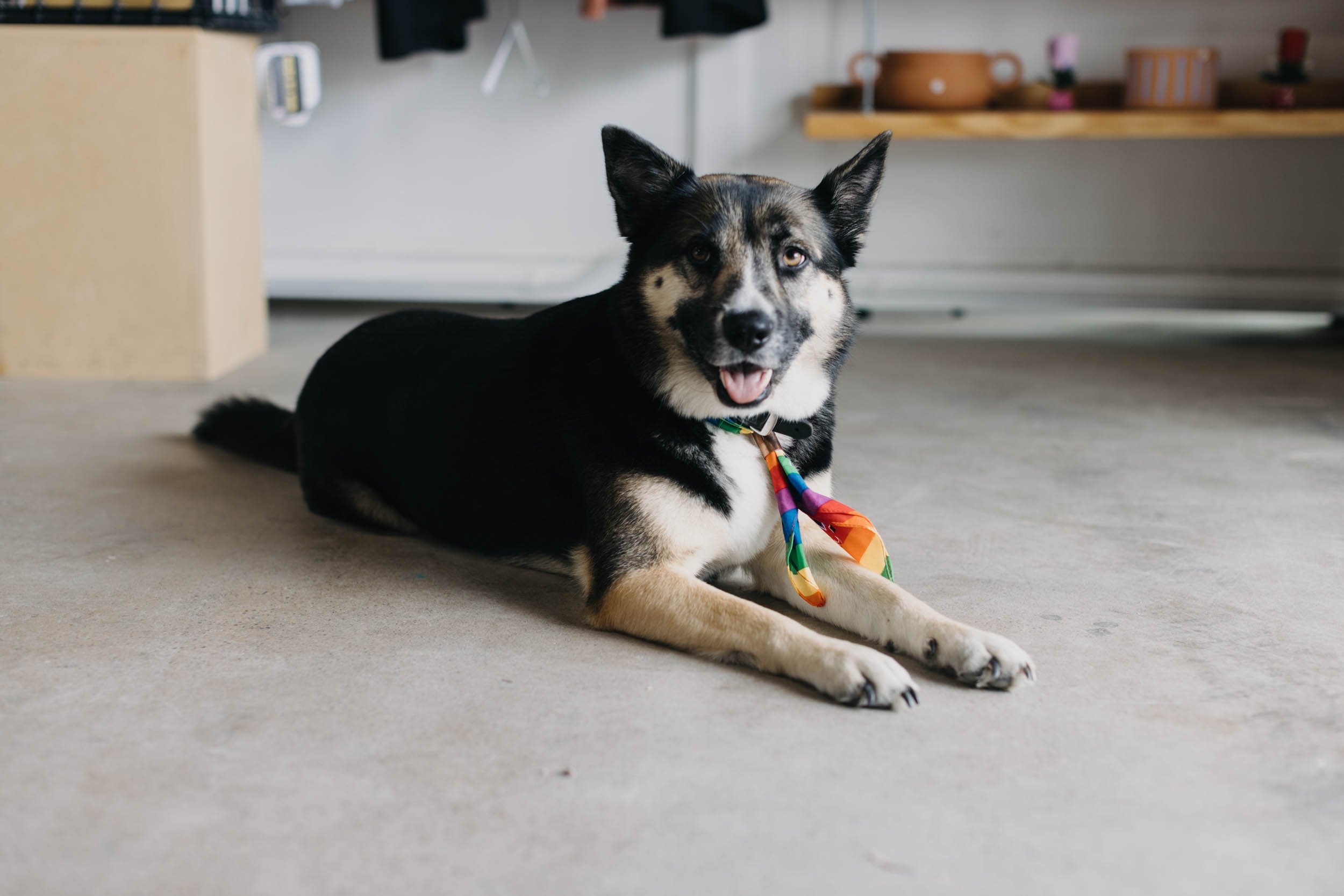A New Kind of Marketplace for Artists
Written By: Grant Klembara · Photography By: Doug Klembara
Walk on the boardwalk of Tyler Station on a Saturday afternoon and you’ll see paintings, pottery, and local artist markets set up outside of Trade Oak Cliff. Recently voted Best Gift Shop for the Oak Cliff Advocate, Trade is an artist studio and shop that showcases 100% art made by local Dallas artists. In addition to their shop, they host monthly ceramics and fibers classes as well as art markets. The space is cooperatively run and operated by artists Brooke Chaney, Corrie Pocta, Charli Miranda, Molly Sydnor, and Niki Dionne.
Prior to coming together as a collective, each artist’s work was primarily available in larger gallery spaces. Through their studio’s studio/shop model that allows them to share their work to their community directly, smaller one- of- a -kind pieces can be found from each artist at accessible price points.
We look forward to diving into the diverse artists and events that happen through Trade in the future and today, want to spend a little time exploring the Oak Cliff history that led Trade Oak Cliff to making Tyler Station their home.
Corrie Pocta, co-founder of the Artist Co-Op + Shop Trade Oak Cliff, remembers walking by Oddfellows back in 2010 as it was being built out. Construction was underway, and there weren’t many people around.
She had previously visited Bishop Arts and Eno’s and immediately fell in love with the area. “It felt like I was in on a secret that no one else knew,” she said.
Corrie, who was still in college at the time, knew exactly how she could get involved. She reached out to the team from Oddfellows to let them know they needed a waitress – and that she was the right person for the job.
They agreed.
When she wasn’t working, she was there reading her college books and meeting people. After getting a job as a waitress at Oddfellows in 2011, she met Gary Buckner, an original partner of the restaurant and owner of Stash Designs. One day she met Gary Buckner, one of the original partners at Oddfellows. After bonding over their mutual interest in creating art, she agreed to do an internship with him. At the end of the internship, she kept pursuing art and went on to spend many years teaching high school art.
Nearly fifteen years later, a pandemic hit; and she lost access to her studio at the school. “When COVID started, I made it a point to get this dusty, barely used kiln working again. I reached out to Gary who helped me get it fixed up and installed in his space,” she said.
Corrie adapted quickly to the changes brought on by the pandemic. She began teaching classes on zoom from her new spot in Gary’s space, for instance. “Everyone and their mother wanted to do clay, literally,” she said with a smile. As she interacted with students, she began to notice a gap in access. Many people were either going to something like a community college for large group instruction, or they were taking private lessons from potters, usually at their house. “I started thinking about the middle way – offering small group classes to the public,” she said.
She had visited Tyler Station for the first time some years earlier when Gary had given her a tour. There were very few defined spaces or tenants at that point, she remembered. It was a cavernous factory that was just coming back to life. “I’m not going to lie – I didn’t think Tyler Station was going to work,” she said with a laugh.
“The idea was that we would all take ownership of the space and spread out the responsibility”
But it continued to grow and by the time the pandemic hit, it was a good place for her to keep her creativity alive. She began spending more time at the factory, working with the kiln and thinking about what she loved doing. As she did, she realized she kept getting drawn back into her love of teaching. She wanted to share her love of art and pottery with others; and she would need an inspiring space to do it.
So with Gary’s guidance Corrie set up a meeting with Monte and found an available space along the boardwalk. It was affordable and she decided to take it; her dream of having a space was coming to life.
She immediately knew other artists could benefit from this space–both as a place to host classes and workshops, as well as a storefront to sell their art. But she needed it to be sustainable. So she began to think critically about how a space with multiple stakeholders might work. “The idea was that we would all take ownership of the space and spread out the responsibility,” she said.
It turned out to be a great system. Every new partner that has joined the Trade Oak Cliff team is responsible for managing the space at least one day a week. In this way, they are able to keep their prices at wholesale since there is no employee to support. As a result, each artist can set their price and take 100% of revenue from what they sell.
“It is a softer art focused on flowing with movement.”
Oh, and in terms of buildout? They were resourceful. “My husband Benj built out the shelving in the space,” she said. They were able to borrow ladders from STASH when they needed to and they bought all of their furniture on Offer Up. And just like that, Trade Oak Cliff was born. “We could immediately say whatever we wanted to say, do what we wanted to do because we didn't have to answer to any investors,” she said. “It was very freeing.”
One of the main stakeholders that joined Corrie was Brook Chaney. She actually also taught high school art in the same district. Corrie had followed her work on instagram (‘madexmom’) and respected her dedication and skill. “I could immediately tell, Brooke knows what she’s doing,” she said. They first met at a Teacher Collaboration Day when Corrie was still teaching; and they hit it off immediately.
So when the opportunity to join forces came up, it was a natural fit. One desire that brought Brook into Trade Oak Cliff was the potential for continuing her pop ups. She had been hosting “Pop Up and Chills” in her backyard and had gained a reputation for bringing local vendors together in a really cool way.
Both Corrie and her were excited at the notion that they could do this in their new space. Today, they host regular pop-ups where artists who are interested in sharing their work can set up and sell their pieces. “We want to share this space with other artists who might not be at the point where they can afford a space yet,” she said.
Nikki Dion and Molly Sidor are two more artists that share the space. Corrie explained that they normally have their work on display in big gallery spaces. “Their work is normally multiple thousands of dollars,” she said. “But in our space they make and sell smaller, more handmade items at a price point many people can afford.”
Charli Miranda is the other core member of the Trade Oak Cliff collective. She used to have a gallery named Muse Gallery near downtown, which closed during the pandemic.
When Corrie talks about Trade Oak Cliff, you can tell that she is proud of it; and for good reason. She helped create a home for some extremely talented women artists whose work and ability to create was hampered by the pandemic. She’s also created a new way for people to experience art in the community, with regular art markets and classes.
When you talk to her, you’ll also hear the gratitude in her voice. She is grateful for the relationship she and so many other women artists have had with Oil and Cotton. “They’ve really inspired a lot of us to start our own spaces and businesses; they are a reason we even exist,” she said.
She is also thankful for Tyler Station as a place for builders and artists. “Local entrepreneurs with an interest in having a space always must ask: Where can I afford to start my business and grow it?” she said.
Tyler Station has proven to be an excellent place to do that for many people.














